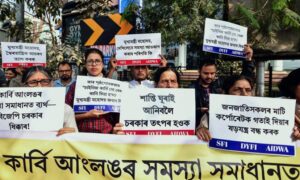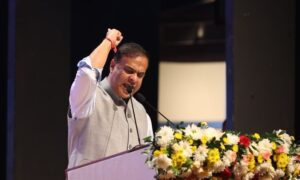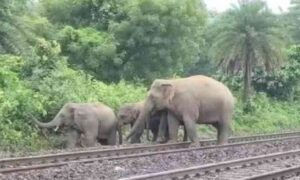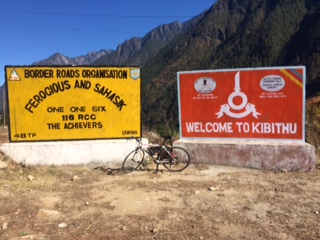
Just below Kibithu, Arunachal Pradesh
Arunachal Pradesh : To and from Kibithu
I left the Inspection Bungalow in Walong at 5:30 am taking advantage of the early sunrise. At the 18 km mark, I was asked a few questions by a Sikh Jawan at a check post. He asked me if I wanted to have some tea and invited me to sit. He then offered me breakfast. When I sat down, he introduced me to his superior who also told him to serve me breakfast consisting of three hot Parathas, some “Sabzi” and two cups of tea. His superior asked me if I had some identity proof and I showed him my Aadhar card as well as my inner line permit.
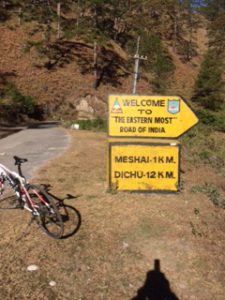
Easternmost road of India, Arunachal Pradesh
When I arrived in Kibithu, I was questioned by Jawans at another check post. They took photocopies of my documents and said that these would be transmitted to Delhi. As it turned out, they knew about my arrival from the people in the previous check post. When I asked one of them if I could visit the village to take a photo where they would be some indication of Kibithu, he sent a Jawan to escort me to the Government Middle School. But he told me that I could not take any other photos. The Jawan escorting me showed me the hills on the LAC (Line of Actual Control) between India and China and pointed to some hills in the distance which were in China. I asked him if I could take photos of the hills to which he said no. He also pointed to some houses in the distance which he said belonged to a village called Dichu which he said was the settlement the furthermost on the Indian side facing China. He also said that the border with China was 3 or 4 km away but that no one could go beyond Kibithu (at least civilians). He also mentioned that there was a Chinese village not very far from the border but that India and China were not connected by road.
When I returned to the check post, the Jawans offered me tea. One of them also said to me that the place where I was sitting was the place where India lost the war to China in 1962. The other Jawan said that we had not lost the war but had just retreated because the supply of rations had been cut off. They then had a brief argument over that.
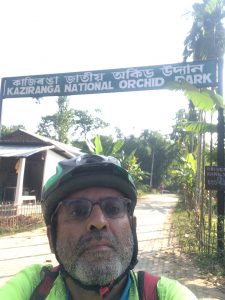
Kaziranga Park, Assam
Assam : between Jorhat and Jakhalabandha
I left in the midst of fog and bad roads in the beginning which improved when I passed the Kaziranga National Park. The park was beautiful at times specially with the forest on the left and tea gardens on the right. I saw two elephants being escorted by people.
Assam : between Guwahati and Howly
I crossed the Brahmaputra River but there was a lot of fog so the visibility was poor. At one Dhaba, when I asked the owner which were the main areas of Guwahati, he said that Fancy Bazaar and Paltan Bazaar were the central parts and that everything else was constructed around them.
Assam and West Bengal : between Gossaigaon and Dhupguri
People waved and smiled at me as I entered West Bengal through the Cooch Behar district. There seems to be a natural transition from Assam to West Bengal as their languages sound similar as do their written scripts. The sight of tea gardens which had disappeared a little before Guwahati reappeared 50 km after Gossaigaon.
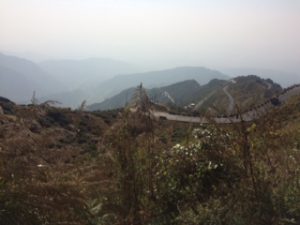
Descent from Darjeeling, West Bengal
West Bengal : between Darjeeling and Islampur
When the sun came out, the whole ride became more bearable. For the first seven kilometers or so till Ghoom, the road was uphill. Subsequently, it was all more or less downhill with the last fifteen or twenty kilometers or so being very steep going downwards forcing one to hold tightly onto one’s breaks. In the region of Bagdogra and onwards, there were again many tea gardens.
Bihar : between Muzaffarpur and Gopalganj
The fog in the morning was again very dense and cold and created visibility problems. After 60 km, a man on his motorcycle slowed down, started asking questions and expected me to pull over and stop. I didn’t want to stop but he then said that he was from the press and that his name was Prabhat Kumar Ranjan of the Pratah Kamal newspaper, a Hindi language newspaper published in all of Bihar or so he mentioned. He offered me a cup of tea and when an onlooker tried to ask me a question, he told him not to interrupt and to listen. He told me that the article about me would be published the following day.
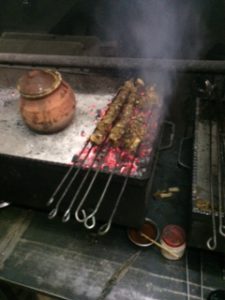
Food in Gopalganj, Bihar
Bihar : in Gopalganj
At a restaurant, they put the Seekh Kababs to roast and requested me to sit down. But I said that I preferred to stand by the fire. When I told them what I was doing, they were very impressed. I had asked for some mutton Seekh Kababs and Chapattis and some mutton gravy to accompany it. But when I sat down to eat, they added pieces of meat to the gravy. They refused to take any money from me in honour of what I was doing.
When I returned to the guest house, there were some people who had lit a fire and who were sitting around it. They asked me to join them for a chat. They said that they had lit the fire for me. When I asked them what Gopalganj was famous for, they mentioned a certain temple and Lalu Prasad Yadav, the notorious Bihari politician. There were two people in that group who worked in the Kidney Dialysis Centre located in the same building and which also housed a hospital. They invited me to visit the Centre which had machinery and patients and of which I took a photo. It was an amazing evening with Bihari warmth and hospitality at its best.
(The writer can be contacted on : WhatsApp : 8940195371)
[the_ad id=’22723′]


